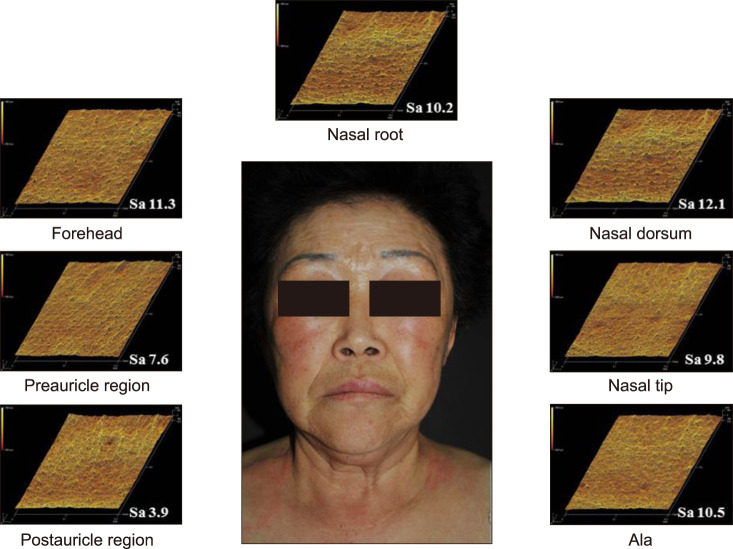Ann Dermatol.
2019 Feb;31(1):1-5. 10.5021/ad.2019.31.1.1.
Comparative Measurement of Biophysical Parameters in Consideration of Skin Graft Donor Site for Nasal Defects
- Affiliations
-
- 1Department of Plastic and Reconstructive Surgery, College of Medicine, Chungnam National University, Daejeon, Korea. djplastic@cnu.ac.kr
- 2Department of Dermatology, College of Medicine, Chungnam National University, Daejeon, Korea. resina20@cnu.ac.kr
- KMID: 2430794
- DOI: http://doi.org/10.5021/ad.2019.31.1.1
Abstract
- BACKGROUND
In planning a skin graft, the texture, color, and size of the recipient and donor site tissues should be considered.
OBJECTIVE
We determined the optimal donor sites for nasal full-thickness skin grafting based on biophysical parameters.
METHODS
Thirty women over the age of 60 were selected for this study. Four recipient sites (nasal root, dorsum, tip, ala) and three donor sites (preauricle, postauricle, forehead) were considered. Biophysical parameters such as transepidermal water loss (TEWL), capacitance, sebum output, erythema/melanin value, and skin replica technique were tested.
RESULTS
The nasal root was correlated with the forehead in terms of TEWL and sebum output. The nasal dorsum was correlated with the preauricle in terms of TEWL, erythema/melanin value, and skin replica measurements. The nasal tip was correlated with the preauricle in terms of TEWL, sebum output, erythema/melanin value, and skin replica measurements. The ala was correlated with the forehead in terms of TEWL and skin replica measurements.
CONCLUSION
The preauricule is the optimal donor site for resurfacing of the nasal dorsum and tip. The forehead is a good donor site for alar defects. For resurfacing of the nasal root, the forehead and postauricle are good choices.
Keyword
MeSH Terms
Figure
Reference
-
1. Chae JK, Kim JH, Kim EJ, Park K. Values of a patient and observer scar assessment scale to evaluate the facial skin graft scar. Ann Dermatol. 2016; 28:615–623. PMID: 27746642.
Article2. Marrakchi S, Maibach HI. Biophysical parameters of skin: map of human face, regional, and age-related differences. Contact Dermatitis. 2007; 57:28–34. PMID: 17577354.
Article3. Barel AO, Clarys P. Study of the stratum corneum barrier function by transepidermal water loss measurements: comparison between two commercial instruments: evaporimeter and tewameter. Skin Pharmacol. 1995; 8:186–195. PMID: 7488395.4. Blichmann CW, Serup J. Assessment of skin moisture. Measurement of electrical conductance, capacitance and transepidermal water loss. Acta Derm Venereol. 1988; 68:284–290. PMID: 2459872.5. Serup J. Formation of oiliness and sebum output--comparison of a lipid-absorbant and occlusive-tape method with photometry. Clin Exp Dermatol. 1991; 16:258–263. PMID: 1838968.
Article6. Yoshimura K, Harii K, Masuda Y, Takahashi M, Aoyama T, Iga T. Usefulness of a narrow-band reflectance spectrophotometer in evaluating effects of depigmenting treatment. Aesthetic Plast Surg. 2001; 25:129–133. PMID: 11349303.
Article7. Park ES, Na JI, Kim SO, Huh CH, Youn SW, Park KC. Application of a pigment measuring device--mexameter--for the differential diagnosis of vitiligo and nevus depigmentosus. Skin Res Technol. 2006; 12:298–302. PMID: 17026663.8. Nedelec B, Forget NJ, Hurtubise T, Cimino S, de Muszka F, Legault A, et al. Skin characteristics: normative data for elasticity, erythema, melanin, and thickness at 16 different anatomical locations. Skin Res Technol. 2016; 22:263–275. PMID: 26333046.
Article9. Ryu JH, Seo YK, Boo YC, Chang MY, Kwak TJ, Koh JS. A quantitative evaluation method of skin texture affected by skin ageing using replica images of the cheek. Int J Cosmet Sci. 2014; 36:247–252. PMID: 24697841.
Article10. Hachiya A, Sriwiriyanont P, Fujimura T, Ohuchi A, Kitahara T, Takema Y, et al. Mechanistic effects of long-term ultraviolet B irradiation induce epidermal and dermal changes in human skin xenografts. Am J Pathol. 2009; 174:401–413. PMID: 19147832.
Article11. Burget GC. Aesthetic reconstruction of the tip of the nose. Dermatol Surg. 1995; 21:419–429. PMID: 7743105.
Article12. Inoue K, Matsumoto K. Quantification of texture match of the skin graft: function and morphology of the stratum corneum. Scand J Plast Reconstr Surg. 1986; 20:31–35. PMID: 3535058.
Article13. Hashimoto-Kumasaka K, Takahashi K, Tagami H. Electrical measurement of the water content of the stratum corneum in vivo and in vitro under various conditions: comparison between skin surface hygrometer and corneometer in evaluation of the skin surface hydration state. Acta Derm Venereol. 1993; 73:335–339. PMID: 7904396.
- Full Text Links
- Actions
-
Cited
- CITED
-
- Close
- Share
- Similar articles
-
- Reconstruction of Basal Cell Carcinoma by Burow' s Graft after Mohs Micrographic Surgery
- Closure of radial forearm free flap donor-site defect with proportional local full-thickness skin graft: case series study of a new design
- Dermis Graft for Wound Coverage: A Preliminary Report
- Immediate regraft of the remnant skin on the donor site in split-thickness skin grafting
- Reconstruction with an Anterolateral Thigh Free Flap Following a Skin Graft from the Same Donor Site for Tissue Use Efficacy: Two Case Reports


